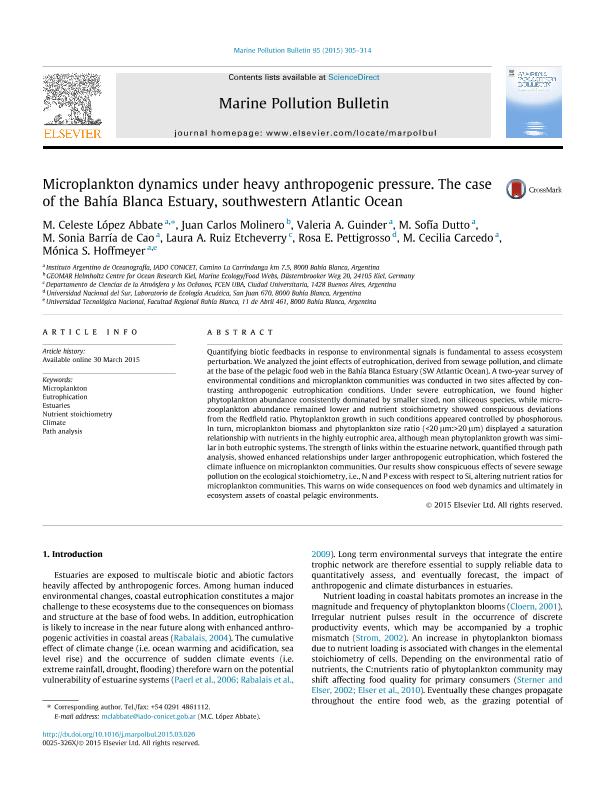Mostrar el registro sencillo del ítem
dc.contributor.author
López Abbate, María Celeste

dc.contributor.author
Molinero, Juan Carlos
dc.contributor.author
Guinder, Valeria Ana

dc.contributor.author
Dutto, María Sofía

dc.contributor.author
Barría de Cao, M. Sonia
dc.contributor.author
Ruiz Etcheverry, Laura Agustina

dc.contributor.author
Pettigrosso, Rosa E.
dc.contributor.author
Carcedo, Maria Cecilia

dc.contributor.author
Hoffmeyer, Monica Susana

dc.date.available
2017-02-03T20:31:37Z
dc.date.issued
2015-06
dc.identifier.citation
López Abbate, María Celeste; Molinero, Juan Carlos; Guinder, Valeria Ana; Dutto, María Sofía; Barría de Cao, M. Sonia; et al.; Microplankton Dynamics Under Heavy Anthropogenic Pressure: the Case of the Bahía Blanca Estuary, Southwestern Atlantic Ocean; Elsevier; Marine Pollution Bulletin; 95; 1; 6-2015; 305-314
dc.identifier.issn
0025-326X
dc.identifier.uri
http://hdl.handle.net/11336/12501
dc.description.abstract
Quantifying biotic feedbacks in response to environmental signals is fundamental to assess ecosystem perturbation. We analyzed the joint effects of eutrophication, derived from sewage pollution, and climate at the base of the pelagic food web in the Bahía Blanca Estuary (SW Atlantic Ocean). A two-year survey of environmental conditions and microplankton communities was conducted in two sites affected by contrasting anthropogenic eutrophication conditions. Under severe eutrophication, we found higher phytoplankton abundance consistently dominated by smaller sized, non siliceous species, while microzooplankton abundance remained lower and nutrient stoichiometry showed conspicuous deviations from the Redfield ratio. Phytoplankton growth in such conditions appeared controlled by phosphorous. In turn, microplankton biomass and phytoplankton size ratio (<20 μm:>20 μm) displayed a saturation relationship with nutrients in the highly eutrophic area, although mean phytoplankton growth was similar in both eutrophic systems. The strength of links within the estuarine network, quantified through path analysis, showed enhanced relationships under larger anthropogenic eutrophication, which fostered the climate influence on microplankton communities. Our results show conspicuous effects of severe sewage pollution on the ecological stoichiometry, i.e., N and P excess with respect to Si, altering nutrient ratios for microplankton communities. This warns on wide consequences on food web dynamics and ultimately in ecosystem assets of coastal pelagic environments.
dc.format
application/pdf
dc.language.iso
eng
dc.publisher
Elsevier

dc.rights
info:eu-repo/semantics/openAccess
dc.rights.uri
https://creativecommons.org/licenses/by-nc-nd/2.5/ar/
dc.subject
Microplankton
dc.subject
Eutrophication
dc.subject
Estuaries
dc.subject
Nutrient Stoichiometry
dc.subject
Path Analysis
dc.subject.classification
Oceanografía, Hidrología, Recursos Hídricos

dc.subject.classification
Ciencias de la Tierra y relacionadas con el Medio Ambiente

dc.subject.classification
CIENCIAS NATURALES Y EXACTAS

dc.title
Microplankton Dynamics Under Heavy Anthropogenic Pressure: the Case of the Bahía Blanca Estuary, Southwestern Atlantic Ocean
dc.type
info:eu-repo/semantics/article
dc.type
info:ar-repo/semantics/artículo
dc.type
info:eu-repo/semantics/publishedVersion
dc.date.updated
2017-02-03T17:53:47Z
dc.journal.volume
95
dc.journal.number
1
dc.journal.pagination
305-314
dc.journal.pais
Países Bajos

dc.journal.ciudad
Ámsterdam
dc.description.fil
Fil: López Abbate, María Celeste. Consejo Nacional de Investigaciones Científicas y Técnicas. Centro Científico Tecnológico Bahía Blanca. Instituto Argentino de Oceanografía (i); Argentina
dc.description.fil
Fil: Molinero, Juan Carlos. Geomar-helmholtz Centre For Ocean Research Kiel; Alemania
dc.description.fil
Fil: Guinder, Valeria Ana. Consejo Nacional de Investigaciones Científicas y Técnicas. Centro Científico Tecnológico Bahía Blanca. Instituto Argentino de Oceanografía (i); Argentina
dc.description.fil
Fil: Dutto, María Sofía. Consejo Nacional de Investigaciones Científicas y Técnicas. Centro Científico Tecnológico Bahía Blanca. Instituto Argentino de Oceanografía (i); Argentina
dc.description.fil
Fil: Barría de Cao, M. Sonia. Consejo Nacional de Investigaciones Científicas y Técnicas. Centro Científico Tecnológico Bahía Blanca. Instituto Argentino de Oceanografía (i); Argentina
dc.description.fil
Fil: Ruiz Etcheverry, Laura Agustina. Universidad de Buenos Aires. Facultad de Ciencias Exactas y Naturales. Departamento de Ciencias de la Atmósfera y los Océanos; Argentina. Consejo Nacional de Investigaciones Científicas y Técnicas; Argentina
dc.description.fil
Fil: Pettigrosso, Rosa E.. Universidad Nacional del Sur. Departamento de Biología, Bioquímica y Farmacia. Laboratorio de Ecología Acuática; Argentina
dc.description.fil
Fil: Carcedo, Maria Cecilia. Consejo Nacional de Investigaciones Científicas y Técnicas. Centro Científico Tecnológico Bahía Blanca. Instituto Argentino de Oceanografía (i); Argentina
dc.description.fil
Fil: Hoffmeyer, Monica Susana. Consejo Nacional de Investigaciones Científicas y Técnicas. Centro Científico Tecnológico Bahía Blanca. Instituto Argentino de Oceanografía (i); Argentina. Universidad Tecnológica Nacional. Facultad Regional Bahía Blanca; Argentina
dc.journal.title
Marine Pollution Bulletin

dc.relation.alternativeid
info:eu-repo/semantics/altIdentifier/url/http://www.sciencedirect.com/science/article/pii/S0025326X1500171X
dc.relation.alternativeid
info:eu-repo/semantics/altIdentifier/doi/http://dx.doi.org/10.1016/j.marpolbul.2015.03.026
Archivos asociados
